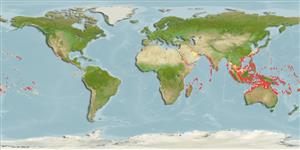>
Gobiiformes (Gobies) >
Gobiidae (Gobies) > Gobiinae
Etymology: Priolepis: Greek, prio = to saw + Greek,lepis = scale (Ref. 45335); cincta: Name from Latin cinctum, a girdle or belt, presumably referring to the banded color pattern; treated as a noun in apposition by Winterbotton & Burridge, 1993:2063 (Ref. 10753).
More on author: Regan.
Issue
Specific name to be examined, treated as a noun in apposition in Ref. 10753, but CofF treat the name as an adjective.
Environment: milieu / climate zone / depth range / distribution range
Écologie
marin; saumâtre récifal; non migrateur; profondeur 1 - 70 m (Ref. 2334), usually 1 - 30 m (Ref. 9002). Tropical; 32°N - 24°S
Indo-West Pacific: Red Sea, Persian Gulf and east coast of Africa to islands of Micronesia, Fiji and Tonga; Japan to Coral Sea.
Taille / Poids / Âge
Maturity: Lm ? range ? - ? cm
Max length : 7.0 cm FL mâle / non sexé; (Ref. 5525)
Description synthétique
Clés d'identification | Morphologie | Morphométrie
Épines dorsales (Total) : 7 - 8; Rayons mous dorsaux (Total) : 11; Épines anales: 1; Rayons mous anaux: 9. Characterized by having alternating dark-edged brown and narrower white bars on head and body; dorsal and caudal fins with brown spotting; basal part of dorsal fins with dark spots/bands; longitudinal scale series 27-31; ctenoid scales on body except cycloid on abdomen, prepectoral and prepelvic areas; upper opercle with a patch of cycloid scales; cheek without scales; depth of body 3.8-4.6 in SL (Ref. 90102).
Hides in caves and crevices (Ref. 9710), also among corals or rock (Ref. 37816). Monogamous (Ref. 52884).
Life cycle and mating behavior
Maturities | Reproduction | Spawnings | Egg(s) | Fecundities | Larves
Benthic spawner (Ref. 31409). Bi-directional sex change was proposed for this species (Ref. 103751). Monogamous mating is observed as both obligate and social (Ref. 52884).
Randall, J.E., G.R. Allen and R.C. Steene, 1990. Fishes of the Great Barrier Reef and Coral Sea. University of Hawaii Press, Honolulu, Hawaii. 506 p. (Ref. 2334)
Statut dans la liste rouge de l'IUCN (Ref. 130435)
Menace pour l'homme
Harmless
Utilisations par l'homme
Pêcheries: commercial; Aquarium: Commercial
Outils
Articles particuliers
Télécharger en XML
Sources Internet
Estimates based on models
Preferred temperature (Ref.
123201): 24.8 - 29, mean 27.7 °C (based on 1094 cells).
Phylogenetic diversity index (Ref.
82804): PD
50 = 0.5000 [Uniqueness, from 0.5 = low to 2.0 = high].
Bayesian length-weight: a=0.00851 (0.00495 - 0.01463), b=3.04 (2.89 - 3.19), in cm total length, based on LWR estimates for this species & (Sub)family-body (Ref.
93245).
Niveau trophique (Ref.
69278): 3.3 ±0.3 se; based on size and trophs of closest relatives
Résilience (Ref.
120179): Haut, temps minimum de doublement de population inférieur à 15 mois (Preliminary K or Fecundity.).
Fishing Vulnerability (Ref.
59153): Low vulnerability (10 of 100).
Nutrients (Ref.
124155): Calcium = 141 [73, 310] mg/100g; Iron = 0.908 [0.442, 1.714] mg/100g; Protein = 18.6 [16.6, 20.2] %; Omega3 = 0.186 [0.081, 0.349] g/100g; Selenium = 24.8 [11.6, 64.8] μg/100g; VitaminA = 131 [35, 444] μg/100g; Zinc = 2.53 [1.67, 3.75] mg/100g (wet weight);
